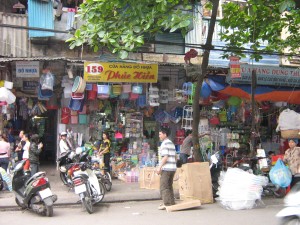In January, before I started this blog, I visited Hoi An in central Vietnam. It‘s an historic river port a few kilometres from the coast, just south of Da Nang and about midway between Hanoi and Saigon.
I stayed with Roe and Colin Schroeder, two Australians who are working as Australian Volunteer International volunteers for a foreign charity operating in Hoi An called the Kianh Foundation, which helps children with disabilities.
Hoi An is a town popular with foreign tourists, who flock to its World Heritage listed town centre. UNESCO says on its website that it is “an exceptionally well-preserved example of a South-East Asian trading port dating from the 15th to the 19th century”.
The visitors also come for the many tailoring businesses that occupy the centuries-old buildings, along with tourist restaurants and souvenir shops selling silk scarves, lacquer bowls, embroidered table runners and ornamental chop sticks.
Not far beyond the this precinct – a couple of minutes’ walk from the most outlying tailoring shop – is the office for the Kianh Foundation. A couple more minutes takes the visitor to the town’s orphanage.
The Kianh Foundation established and runs an onsite special-education school for the children with disabilities who live there, where they receive an education that’s tailored to their abilities. The foundation also pays the wages of five of their carers, for services such as physiotherapy, speech therapy and dental care and for excursions and other social activities.
I visited the orphanage with Roe and Colin Schroeder, and found the school rooms for the children, some of whom have severe disabilities, to be a bright, sociable and cheerful hive of activity, and well stocked with books and toys.
Conditions were drastically different in 2001 when two English tourists visited the orphanage while on a holiday to Hoi An. They found the orphans with disabilities lying two or three to wooden beds in a dark room. The Kianh Foundation website says: “The children’s lives were lived out solely on the beds: they ate there; went to the toilet there. They never left the room. They had a small amount of food, no toys, no books, no games, no music. They just existed.”
The pair decided to set up the Kianh Foundation. One of the founders, Jackie Wrafter, is now the director of the charity and others have joined their efforts, in particular the Schroeders. They had also initially visited the orphanage while on holidays to Hoi An, in 2003. They have been returning regularly ever since, currently for 18 months on the Australian Volunteers International placements.
Now the charity is setting up a brand new day centre for disabled children in the nearby agricultural region of Dien Ban, so that its work can extend beyond the orphanage.
Roe Schroeder has for years trained the teachers for the school at the orphanage, and is now setting up the educational program for the day centre. Twenty children are already being helped, in temporary premises, with special education, physiotherapy and speech therapy. Roe is training three teachers and one teacher’s aid. Another Australian Volunteers International volunteer, a paediatric physiotherapist, is training an assistant physio and will shortly start training two graduate physios.
Colin Schroeder is the project manager for the centre’s permanent home, which will be purpose-built on land made available to the charity by the local authorities.
The Kianh Foundation website says Dien Ban was bombed heavily with dioxins during the war with the Americans and has the highest proportion of people with disabilities in the local province.
The dioxins were contained in herbicides including Agent Orange. This recent report from the US-Vietnam Dialogue Group on Agent Orange/Dioxin outlines the extent of the problem in Vietnam.
For those in Hoi An on holidays a visit to the Kianh Foundation and the orphanage shows a side of Vietnam far removed from the souvenir shops and tourist cafes. The charity and its dedicated staff and volunteers work hard to enrich the lives of children who otherwise might have little chance for health, personal growth or joy in their lives.
Donating money to the charity helps it to continue and expand its work for children with disabilities The Kianh Foundation, which is a registered charity in Great Britain, depends on donations from individuals to carry on with its work. Donations to it really do make a difference in the lives of these children of Hoi An and Dien Ban.








